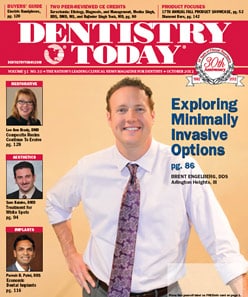As time has passed, and the dental industry has become more comfortable with the scientific data supporting the high success of properly placed dental implants, the desire for speed has come to the forefront of implant dentistry. Immediate implants can mean several things, depending on the context in which they are described, but in all cases this concept is geared for a quicker replacement for missing teeth. As with most areas of dentistry, it is imperative to temper speed with results–it is imperative to avoid a compromise in quality for the benefit of speed!
Options for Immediate Dental Implants

Traditionally, if a tooth was to be lost and replaced with a dental implant, the area was grafted or augmented, and a healing phase ensued. This allowed for adequate healthy bone at the site of the extraction, and therefore an implant placed in the future would be assured a greater chance of success. In fact, a period of three to six months is normal prior to implant placement after an extraction, bone graft, and sinus lift when an infected tooth is removed. After this waiting period, an implant can be placed below the gum line, and an additional waiting period of up to four months can begin prior to the implant being exposed and ready to restore. Some restorative dentists even choose to progressively load the implant with chewing forces gradually over several weeks or months prior to placing the definitive restoration. All of the previously described procedures are geared to increase the odds of success, yet are at times frustrating for patients who are eagerly anticipating that their dentistry be completed.
Immediate implants, according to one of the initial definitions of the expression, meant that at the time of an extraction, an implant is placed in the extracted tooth socket. A waiting period of up to several months would then start prior to restoring the implant, yet this could be considered immediate as the implant was placed “immediately” at the time of the extraction. Even though several months must pass prior to the treatment being completed, this is a form of “immediate” for many dental implant surgeons and benefiting patients.
Taking immediate implants a step further, today, many cosmetic dentists opt for an extraction and immediate implant placement along with the simultaneous final abutment placement in the esthetic zone. This abutment is placed and never removed in order to theoretically maximize the amount of pink gum tissue that is kept in the future. This concept of “one abutment, one time” is currently becoming mainstream for reaching long-term esthetic ideals in the anterior region of the mouth, though a major compromise is the need to utilize a stock abutment in these cases.
Continuing farther into the concept of immediate implant placement, a tooth can be removed, an abutment placed and prepared, and the final crown be fabricated immediately for the implant at the time of the surgery. This technique, of course, carries several risks that are not associated with the more traditional implant procedures which advocated a healing period prior to restoring the implant. Loading an implant (functioning or chewing with the implant) immediately is thought to decrease the likelihood of osseointegration of the implant, and therefore lower the odds of success of the implant. At the time of any surgery, no matter how careful the placement is, there is bleeding and inflammation which can decrease the laboratory’s ability to create a perfect final tissue contour of a crown if the impression is made the same day.
Nevertheless, many patients have pushed for such procedures to eliminate the waiting time required for having their lost teeth replaced. It must be understood by a patient that substantial risks are assumed as the process is accelerated.
All-On-Four and Other Dental Implant Techniques
Corporate dental implant placement centers such as Clearchoice and Eon Clinics have started in order to target the growing market of patients who have lost some or all of their teeth, and are willing to pay to replace them “now.” Many of these centers employ their own laboratory technicians, dentists, and surgeons who appeal to patients who want to have all of their teeth removed and replaced with dental implants–all in one day. This concept is even marketed as “teeth in a day” by these companies, however this is actually false. A more accurate description would be that after several diagnostic steps and financial arrangements have been made, these clinics are willing to extract your teeth and connect a provisional set of dentures to your implants on the day that you have your teeth removed in the right situation. The talent level of the restorative dentists and surgeons at these facilities varies, and usually the patient is referred to a dentist who has paid a fee to partner with these clinics to have their final prosthesis made several months later, if a patient so desires. The most commonly marketed concept at these facilities is the “all on four” concept, where only four implants are placed at unusual angles which can usually maintain a full arch denture for a long period of time with a high level of success.
All on Four is a technique for total rehabilitation of an edentulous arch, either upper or lower. This technique was invented by a Portuguese dentist named Paulo Maló in the 1990’s, and has been used in the United States for many years. It consists of the rehabilitation of the edentulous maxilla and mandible with a fixed prosthesis by placing only four implants in the anterior maxilla, where bone density is higher, which therefore allows for a potentially higher success rate. The four implants support a denture prosthesis with twelve or more teeth that are connected immediately on the day of surgery. The benefits of this technique are obvious: immediate implant restoration at a reduced cost due to the expense of only four implants. However, there are several drawbacks to this procedure, with the main disadvantage being that if one implant fails, there is no possibility of “All On Three” working, and the entire prosthesis and implant scheme must be reconfigured.
Dr. Brent Engelberg has restored many cases with a modified version of this concept, where four to six implants are immediately placed and a prosthesis is immediately attached on the day of the surgery. In addition, to make the process smooth and seamless, the periodontists and oral surgeons that work with Dr. Engelberg on these procedures simply split the cost for the total procedure to make the financial arrangements easier for the patient. This also is assuring to patients who want a talented team of surgeons, technicians, and Dr. Engelberg working as a team together with you to complete the work. In the corporate dental centers, the quality of the restorations can be highly variable, and there are no choices for the patients in terms of who will complete each portion of the rehabilitation.
Furthermore, this fee also includes all of the initial diagnostic photography, impressions, x-rays, scans, and CBCT imaging. The fee also includes two unique restorations: the immediate fixed denture restoration, attached to the implants on the day of implant placement, and the final framework-supported prosthesis made several months later after the bone remodeling is completed. The second restoration is much more ideal then only an initial immediate restoration, as perfect tissue contours and esthetics can only be achieved after a trial with the initial prosthesis for several months.
In addition, the more implants that are placed, the higher the success rate of these restorations, and Dr. Engelberg and his talented surgeons always attempt to place six implants as opposed to four implants for the patient’s benefit, and never charge additional fees to the patient. The patient’s best interest is the most important thing, and if two additional implants can be placed, the cost of additional implants by the surgeon and implant components for Dr. Engelberg are absorbed for a far superior clinical outcome. This philosophical difference is absolutely a great benefit for all patients who desire an immediate fixed implant supported prosthesis, and patients are encouraged to call Dr. Engelberg for details on this format of rehabilitation.












